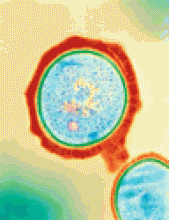A 48-year-old male custodian at a historic site was well until he vacuumed a collection of animal pelts (beaver, muskrat, bear, rabbit, and bison) of unknown age. Within 3 days, he developed a vesicular lesion on his left fifth finger and a pruritic area on his left medial thigh. Over the next 2 days, the finger lesion evolved to a furuncle and the thigh lesion became indurated, painful, and swollen. He was treated with oral cloxacillin, but his pain increased and he experienced generalized malaise, and myalgias. A re-evaluation at 9 days after contact with the pelts showed that his left fifth finger was swollen and erythematous, the finger furuncle had ruptured (Fig. 1) and the left medial thigh lesion had become a necrotizing abscess with purulent debris (Fig. 2).
Fig. 1: A 4-cm patch of erythema on the patient's left fifth finger.
Fig. 2: An 11-cm erythematous patch on the medial aspect of the patient's left thigh. The area was exquisitely painful, with central fluctuance.
He was afebrile, with no lymphadenopathy, a leukocyte count of 7.1 109 cells/L and a normal leukocyte differential. Absence of improvement with cloxacillin raised suspicion of a zoonotic infection such as tularemia. Because results were still pending on a culture of the pus, his antibiotic was changed to gentamicin (5 mg/kg, delivered intravenously once a day). This caused the erythema around both lesions to regress markedly and the thigh pain to decrease within 24 hours. The thigh lesion was incised and drained.
Methicillin-resistant Staphylococcus aureus (MRSA) was the only microorganism recovered from the cultures. The patient had not had contact with any health care facility, nor had he been in contact with anyone who during the previous 5 years had been admitted into a hospital or who had a furunculosis or skin or soft-tissue infection. He had not shared work gloves or other equipment with other workers.
After 5 days of intravenous administration of gentamicin, the antibiotic was changed to TMP/ SMX, a double-strength trimethoprim (160 mg)–sulfamethoxazole (800 mg) tablet taken by mouth twice a day for 2 weeks. This regimen led to the complete resolution of the finger and thigh infections.
Molecular analysis of the thigh isolate showed the mecA and lukF–PV–lukS–PV genes encoding the Panton–Valentine leukocidin (PVL) toxin. DNA fingerprinting with pulsed-field gel electrophoresis and comparison with the Canadian “MRSA fingerprint” database revealed that the strain was indistinguishable from CMRSA10 (type 0473), identical to the USA300 clone, a community-acquired (CA) MRSA clone that has been implicated in skin and soft-tissue infections in people unassociated with health care facilities.1,2 The microorganism was resistant to oxacillin, erythromycin and ciprofloxacin, but sensitive to gentamicin, tetracycline, TMP/SMX and vancomycin.
The patient returned 30 days later with a scrotal abscess; it was drained, and CA-MRSA was recovered. Swabs of the anterior nares for culture also yielded CA-MRSA. He underwent a 14-day decolonization regimen of TMP/SMX (1 double-strength tablet taken orally twice a day), rifampin (two 300-mg capsules, once daily) and mupirocin ointment applied twice daily to the anterior nares. Five subsequent screening swabs of the anterior nares and throat did not yield MRSA.
This case is typical of CA-MRSA infections, particularly in the lack of traditional risk factors in the patient for MRSA acquisition, its spontaneous onset and the clinical manifestation of furunculosis. When the patient first arrived, it was speculated that he may have developed a zoonotic infection (e.g., tularemia) from contact with the animal pelts; infection with MRSA was not initially considered. MRSA has, however, been recovered from people, such as this patient, without known risk factors for nosocomial MRSA, including North American Aboriginal people, children, prisoners, soldiers and athletes, where crowding and suboptimal hygiene may facilitate transmission. For many MRSA infections, such as in the case we describe, a clear source cannot be established.1–3 Our patient's contact with the animal pelts was likely coincidental and not a risk factor for CA-MRSA infection.
In some regions, CA-MRSA has replaced oxacillin-susceptible strains as the predominant pathogen in infections aquired in the community. CA-MRSA infection is diagnosed when MRSA is isolated within 72 hours of hospital admission from people who have no known risk factors for hospital-acquired MRSA (e.g., without prior hospital admission, indwelling devices or hemodialysis).3 CA-MRSA is associated with the genetic element known as the staphylococcal cassette chromosome mec region (SCCmec) type IV, whereas hospital-acquired MRSA is associated with SCCmec types I, II and III.3 CA-MRSA is resistant to fewer antimicrobial agents (primarily the β-lactams), whereas multidrug resistance is common among hospital-acquired MRSA infections. CA-MRSA frequently produces the PVL toxin, which kills neutrophils; it has been associated with furuncles, cutaneous skin ascesses, necrotizing pneumonia, necrotizing fasciitis, myositis, osteomyelitis and prosthetic-joint infections.3
This case highlights the potential importance of CA-MRSA as an emerging pathogen. Caregivers should heighten their index of suspicion about the presence of this pathogen whenever first-line treatment does not induce an appropriate response, and modify the patient's therapy accordingly.
Footnotes
-
Acknowledgements: We thank Dave Spreitzer and Tim Du for conducting the molecular analysis of the bacterial strain.
Competing interests: None declared.













